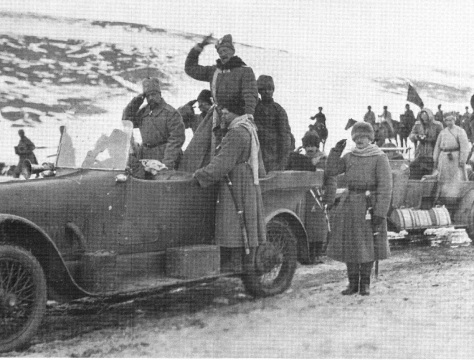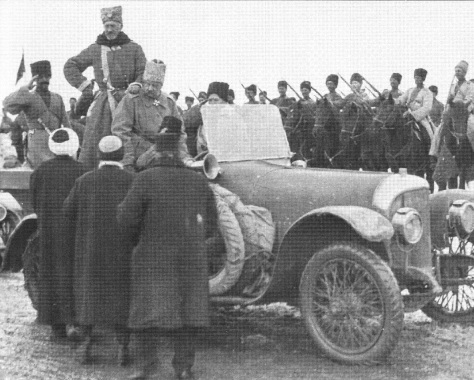Today is the 100th anniversary of one of the greatest Russian victories of the First World War – the capture of the Ottoman fortress of Erzerum on 16 February 1916.
The Erzerum complex, consisting of a core of 11 forts and batteries with two more forts on each flank, and with a garrison of 50,000 men and 300-400 guns, was the centrepiece of the Ottoman line in Anatolia, Eastern Turkey. Against it were 80,000 troops of the Caucasus Army of the Russian Empire. Thus, although the Russians had an advantage in numbers, it was not at all the 3-1 majority normally considered necessary for a successful attack, let alone an attack against such a powerful objective.
The Caucasus Army had begun an offensive against the Turkish defences in Anatolia on 10 January 1916. The idea was to inflict a serious defeat on the Turks before reinforcements could arrive from Gallipoli, which had recently been abandoned by the British. Six days after the offensive began, the Turks abandoned their positions and withdrew towards the protection of Erzerum. On 19 January, the Chief of Staff of the Russian First Caucasian Army Corps, Major General V.G. Lastochkin, telegraphed the Viceroy of the Caucasus, Grand Duke Nikolai Nikolaevich, asking for permission to assault Erzerum on the run with the forward elements of his corps before the Turks could organize their defences. The Grand Duke rejected the proposal, considering it too dangerous, and the Russians waited until they had brought up all their forces before preparing their next move.
At the end of January, the Commander of the Caucasus Army, General N.N. Iudenich, decided to risk an all-out assault on the fortress. Grand Duke Nikolai Nikolaevich was reluctant to give his approval, but eventually relented and on or around 1 February gave Iudenich permission to proceed. On 11 February 1916, the assault began.
The Russian point of main effort was an attack across the Kargapazar ridge north of the fortress. The Turks had left this mostly undefended due to the mountainous terrain and the harsh winter conditions, which they felt made the ridge impassable. The Russian soldiers were, however, able to cross the ridge in force, and by 14 February had outflanked most of the fortress’ defences. The next day, the Turks began to abandon Erzerum, and on 16 February the Russians entered the city. “The Lord God has given such great help to the super-valiant forces of the Caucasus Army that after an unprecedented five-day storm Erzerum has been taken,’ the Grand Duke telegraphed to the Tsar, adding that his army had taken 14,000 prisoners.
After Erzerum the Caucasus Army continued to advance westwards into Anatolia. The Ottoman Army never fully recovered. Had the revolution of 1917 not intervened, total Russian victory over Turkey would have been assured.





Great post – and a reminder that the First World War was a lot wider than just the Western Front. There was also a fairly vigorous naval side to the Russo-Turkish war that is also seldom remembered these days.
LikeLike
The history of the Russian Caucasus Army remains very under-researched. As far as I am aware, the only archive-based book on the subject came out in the mid-1970s. The naval side of the war, as you say, is also very neglected – lots of PhD subjects there for anyone willing.
LikeLiked by 1 person
Hopefully we will soon be able to refer to this as ‘precedent’. Great post, very interesting and a story well-told.
LikeLike
Some photos from that time and place:
1) Photo in Amalgamated Press (London):
2)
Grand Duke Nikolai Nikolaych in center. To his right another Nik Nik – Yudenich.
3) Captured Turkish soldiers:
4) Trophy artillery captured in Erzerum:
5) The original “movie” about Erzerum’s capture:
” Had the revolution of 1917 not intervened, total Russian victory over Turkey would have been assured.”
Bloody eSeRs! [nods]
LikeLiked by 1 person
Thanks for those, Lyttenburgh. They give a very good sense of the extremely tough terrain and weather the Russians had to overcome to achieve this victory. It was an immense physical feat.
LikeLike
”Had the revolution of 1917 not intervened, total Russian victory over Turkey would have been assured.”
Yep. And had my grandmother been born with four cylinders and a carburetor, then she would have been a Toyota engine!
LikeLike
Gallipoli was abandoned by the British and the French and various British Imperial and Dominion troops. I think that the French role at Gallipoli is often forgotten. And contrary to the popular perception that ANZAC troops were slaughtered whilst the British drank tea on the beaches, the British suffered the most killed in action (34,072) during the campaign, followed by the French (9,798). The Australian and New Zealand KIA amounted to 8,709 and 2,721 respectively, which ANZAC dead, of course, amounted to a horrendous proportion of the male population of those two British dominions.
LikeLike
I just had a look at a map of Erzurum to see where it is and I was surprised to see it is quite deep in NE Turkey.
Had the Russians been able to hold Erzurum, they might have been able to claim the entire area for the Armenians and the city and its province (also called Erzurum) might now be part of modern Armenia.
LikeLike
The Russians weren’t actually too keen on the idea of an independent Armenia, lest it attract the loyalty of the Armenians who lived within the Russian Empire. Thus Grand Duke Nikolai Nikolaevich wrote to Foreign Minister Sazonov that, ‘There is no more an Armenian question than there is a Yakut one.’
LikeLike
“Had the Russians been able to hold Erzurum, they might have been able to claim the entire area for the Armenians and the city and its province (also called Erzurum) might now be part of modern Armenia.”
Kinda like that?
Remove kebab, remove kebab! Erzerum is Armenian clay! Lake Van is Armenian clay too! 1915 never forget! Remove Turk from premises!LikeLike
Read this one years ago on the Black Sea Fleet operations during WW1: North of Gallipoli: The Black Sea Fleet at War, 1914-1917 Hardcover – August 15, 1992 by Professor George Nekrasov (Author)
One of their planned but not carried out operations was a sizeable diversionary landing on the coast of Bulgaria!
LikeLike
It might be apropos to mention Alexander Pushkin’s earlier trip to Azrum, in 1829, of which he wrote this interesting travelogue.
Creepily enough, in one passage Pushkin writes how he met a group of Gruzians arriving from Teheran. When he asked them what they were carrying, they replied: “The body of Griboedov.” More like pieces of his body.
LikeLike
What were Russian WWI actual goals, in regard to Turkey? Does anyone know? Was it purely defensive, to keep Turks from taking back Ottoman territories?
LikeLike
It depends who you are talking about. The Foreign Ministry had its beady eye on Constantinople. Sazonov also wanted to annex eastern Anatolia and Turkish Kurdistan. He was quite ambitious. The generals, on the other hand, saw the Turkish front as a sideshow and had far more limited aspirations. They wished to concentrate the maximum amount possible on the main front against Germany and Austria-Hungary. On the Turkish front, their primary objective was to just reduce the Turkish threat as much as possible, so that Russia could minimize the amount of resources it had to spend countering it.
LikeLike
I’m coming to this a little late, never the less a great post and wonderful pictures. I’m writing a novel partly set at that time in Trabzon, taken by the Russians shortly after Erzerum (as I’m sure you know). Any info/pics very gratefully accepted! Thanks!
LikeLike
Hi,
On pages 282 and 283 on my book ‘Grand Duke Nikolai Nikolaevich: Supreme Commander of the Russian Army’, I describe a trip that the Grand Duke made to Trabzon in summer 1916. I got the information from the archive of A.V. Shvarts in the Hoover Institution Archives.
I don’t seem to be able to post photos in comments, or at least I haven’t worked out how to do that, so instead I’ve added three more pictures at the bottom of this post, showing the Grand Duke in his car at Erzerum reviewing Russian troops. I think that these are from his nephew’s memoirs: Prinz Roman Romanow, ‘Am Hof des letzten Zaren’ (Munich: Piper, 1991). Roman accompanied the Grand Duke to Trabzon. His sister, Princess Marina Petrovna, was working there as a nurse.
LikeLiked by 1 person
Thank you!
LikeLike